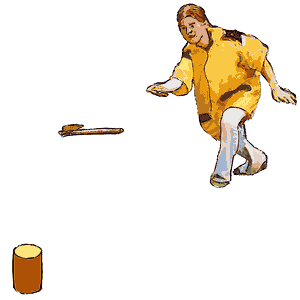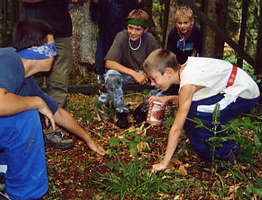source: www.youthwork-practice.com | 2000 Games, Devotions, Themes, Ideas and more for Youth Work
only for private using
Red Indian games
In our Red Indian games, all sporting requirements should be tested (speed, running technique, creeping, throwing) along with creative abilities (Red Indian dance and song) and intellectual capabilities through games such as making smoke signals, solving clues and memory games. There is something for everyone and the strength and weaknesses of each player are strongly tested. Everyone has the chance to collect points here and there. We will omit pure tests of braveness, but the sum of the collective games is actually very close to a Red Indian test.
Red Indian test | Station games
-
Bison hunt
A member of group either sits in a kart and is pushed along by the others, or he sits on the back of one of his team mates. The player has a lance in his hand. Now he must run past several bison made from cardboard (standing up is not allowed) which must be hit/knocked over.
-
War path
The group does a Red Indian dance with Red Indian cries (judging: resourcefulness, rhythm and suitable movements, singing)
-
Scouts
Who can recognise objects (marks on a tree, different coloured feathers etc) at a distance of 20-30 meters?
-
Sense
A total of 16 different stones are laid out on the ground in 4 rows of 4. After looking at the stones and trying to remember what they look like, 2 stones are swapped. Will the group notice which ones have been swapped?
-
Archery
A target is shot at with a bow and arrow, or the player tries to fire a bow as far as possible. When taking part in the station game, it is very important that the spectator/group members are standing behind the person who is shooting and that the members of staff are not in the firing line. The target position should be chosen so that there is no chance of someone being behind the target or being hit accidentally (no path, no tent, no street and no house). The arrows should only be collected once all of them have been fired.
-
Tomahawk throwing

Similar to shooting cans, however instead of a tennis ball; we will use a wooden or plastic Tomahawk. The number of cans which fall are counted. Alternative: The tin can targets are placed next to each other at a distance of 50cm. Each child has one throw to hit at certain can.
-
Javelin
A spear is thrown at a bison drawn on the grass. Points are awarded depending on where the spear lands. Alternative: The bison is made from cardboard.
-
Buffalo hunt
A spear is thrown through a tyre which is hanging in a tree at a distance of 5-8 meters. Alternative: The tyre is swinging lightly.
-
Wanderings
The tribe of Indians moves on. Tents, older tribe members and children are pulled along on carts by horses. A member of the group is carried by two other group members for a distance of approx. 50m (2 tree trunks as a stretcher, cross sections for stability and an old blanket for the surface).
-
Indian sayings
The various Indian tribes communicated with each other using sign language. A member of the group receives a message which he must communicate to the rest of the group using sign language. Alternative: Approx. 10 signs are practised beforehand and 3 should be performed.
-
Smoke signals
1 sign from a possible 10 is allocated in the fire camp, which 2 people must perform – the other must guess which smoke signal it was. The group receives a sketch with possible smoke signals.
-
Track and trail reader
In a section of forest approx. 100x100m, different tracks, directions and signs (broken twigs etc.) are laid out. Will the group find all of the clues and tracks? Alternative: Can the group use the tracks to find some treasure?
-
Silent creeping
The leader blindfolds himself and the players must try to find and take object from an area of 5 x 5 meters or from a room without being caught. The time limit is 2 minutes in each round and a second group leader observes the game.

Alternative 1:
The member of staff sits on the ground with their legs spread out to the side. The following objects are between their legs: a stone, a can with a stone inside and a can with a stone on top. A member of the group tries to sneak up and take the items without being noticed. The member of staff is only allowed to take a swing 5 times and the player has 2 minutes.Alternative 2:
The member of staff sits on a higher position (cliff, perch or tree). The group now has the task of trying to find out approx. 10 letters or numbers which are near to the member of staff without being discovered. A second member of staff observes the game and may also collect up the numbers which are found. If the player is discovered, he is out of the game. This person is also not allowed to name/communicate/call out the number and must remain under the tree/cliff until the game is over. A thick forest, a fir tree forest or a terrain which is not easy to see through with lots of bushes, alcoves and dips is suitable for this game (another tip: the staff mustn’t see everything).Alternative 3:
The same as alternative 2 but each creeper receives a hut with a number on it. If the member of staff sees and calls out the number, the player is out of the game. -
Bola throwing
A bola (2 small fist-sized leather bags filled with sand and attached to an approx. 50cm long rope) is thrown into a target area (circle/post). Points are awarded according to the accuracy of the throw.
-
Red Indian artwork (beading pearls)
How many pearls/beads can be thread onto a piece of string within 2 minutes? One point is awarded for every 10 (or 15) pearls – a maximum of 10 points are possible.
-
Pony riding
2 children who are approximately the same size kneel down next to each other. A third child kneels on top. How many meters can the trio move along without the rider falling off? (No hands are allowed to hoist himself up).
-
Nimble as a weasel – agile as a snake (crawling)
The Red Indians creep up on an enemy camp. We will crawl through the terrain. A) Underneath ropes b) in zigzags through a rope labyrinth c) over a tree trunk d) crawling over a bench which is laid across a stream etc.
-
Blowpipe shooting
A short plastic pipe approx. 30-50 cm long serves as a blowpipe. Small bullets made from paper are the ammunition. The target is a tin can or some playing cards built into a pyramid.
-
War dance
The judging of an Indian dance is judged on: Costume, resourcefulness, suitable movements and rhythm and suitable sound effects
[ © www.youthwork-practice.com | 2000 Games and Ideas for Youth Work ]






